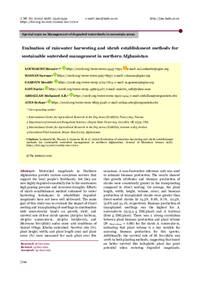Evaluation of rainwater harvesting and shrub establishment methods for sustainable watershed management in northern Afghanistan

Authors:
Watershed rangelands in Northern Afghanistan provide various ecosystem services that support the local people’s livelihoods, but they are now highly degraded essentially due to the continuous high grazing pressure and recurrent droughts. Effects of shrub establishment method enhanced by water harvesting techniques to rehabilitate degraded rangelands have not been well addressed. The main goal of this study was to evaluate the impact of direct seeding and transplanting of seedlings in combination with semi-circular bunds on growth, yield, and survival rate of four shrub species (Atriplex halimus, Atriplex nummularia, Atriplex lentiformis, and Maireana brevifolia) under semi- arid conditions of Sayyad village, Khulm watershed. Survival rate (%), plant height, width, and plant length (cm) and plant cover (%) were measured for each plant over five occasions. A non-destructive reference unit was used to estimate biomass production. The results showed that growth attributes and biomass production of shrubs were consistently greater in the transplanting compared to direct seeding. On average, the plant length, width, height, volume, cover, and biomass production of transplanted shrubs were greater than direct-seeded shrubs by 24.3%, 8.6%, 8.7%, 121.5%, 13.8% and 34.1%, respectively. Biomass production of transplanted seedlings was the highest for A. nummularia (1313.5 g DM/plant) and A. halimus (800 g DM/plant). There was a strong correlation between plant biomass production and plant volume (R2 Plant volume = 0.88) for the shrub A. nummularia, indicating that plant volume is a key variable for assessing biomass production for this species. Additionally, the survival rate of M. brevifolia was 100% in both planting methods, suggesting that based on better survival this halophytic plant has great potential when restoring degraded rangelands. Collectively, on the basis of better growth rates, yield, and survival, transplanting A. nummularia and A. halimus may enhance shrub establishment and contribute to the rehabilitation of sloping semi-arid degraded areas of Northern Afghanistan.
